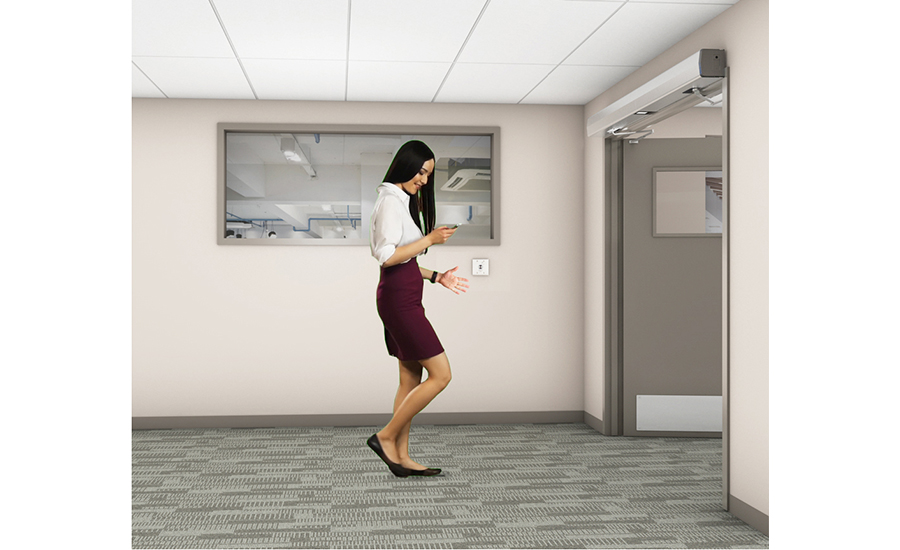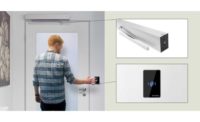Thomas Paine, an early American philosopher, once said, “These are the times that try men’s souls.” Although these insightful words were written in reference to the American Revolution, they embody the sufferings of so many people today, due to the proliferation of COVID-19.
In an attempt to address the issue of physical contact with surface-laden infections, manufacturers in the areas of electronic access control and security have sought to create an assortment of contact-free methods whereby the general public can gain access and leave commercial structures, multiple-tenant apartments, office buildings, and more without the fear of contracting this disease.
According to Lisa Corte, director of product management, electronic access control, ASSA ABLOY Opening Solutions, New Haven, Conn., “The need for touch-free access has been accelerated by the demands of the COVID-19 pandemic. Reducing touchpoints at high-volume openings is essential not only to create a safer environment, but also to ensure some level of continuity within our daily lives.”
Contact-Free Access
The security industry has long provided touch-free access by way of a variety of devices capable of identifying users through a unique identifier. One example is the proximity reader. Although the read range is typically 1 to 4 inches, the industry has expanded it using radio frequency (RF) technology so the user can be up to 20 feet away from the reader in some cases.
“Due to pandemic related concerns some companies are re-purposing long-range readers, traditionally used for vehicle gates, etc., to be used with pedestrian doors,” says Greg Peninger, regional sales manager, Rosslare Security Products, Southlake, Texas. “These long range readers paired with an ISO-styled printable card and a door opener can provide completely hands-free entry or exit.”
The Mechanics of the Coronavirus
From a causality perspective, there are two schools of thought when it comes to how viruses like SARS-CoV-2 (the virus that causes COVID-19) is acquired. The World Health Organization (WHO) and the Center for Disease Control (CDC) both endorse the theory that the coronavirus is passed person to person by way of droplets at short distances, hence the 6-foot distancing rule. The second theory, often referred to as “aerosol action,” involves the transmission of virus by way of the air we breathe. In both theories, the issue of transmission of an infection by way of surface retention is accepted to one degree or another.
For this reason, David Price of Camden Door Controls says that the use of touch-free devices — used to activate door operators or de-energize locking devices — is on the rise at an unprecedented rate.
The security industry has had to step up, accelerating plans to provide clients with the touch-free devices they need, not only to assure the safety of employees and those who visit, but also to satisfy the long-term changes that will occur due to the codification of new health-related specifications.
Biometrics are another choice that fosters a touch-free environment when accessing buildings. Facial recognition and eye-based access are the two most common. Smartphone access, although not new, has seen an increase in use as commercial companies seek to help employees return to work.
One example of a mobile access app designed specifically for access control is ScanPass, manufactured by Connected Technologies of Monument, Colo. “Connected Technologies developed ScanPass Mobile Credential so end users can use their smartphone for contactless, friction-free access control,” says Mike Simon, managing partner, Connected Technologies. “Users simply point their smartphone at a bar code [label] affixed at the door.”
There are other manual options that work well for touch-free access. Using an encrypted wireless system, it’s possible to provide trusted users with a small wireless transmitter that can be kept on their person at all times, such as a wireless key fob.
“An alternative to installing a sensor device that will enable a door to open automatically is to provide each building occupant with a manual activation device that only they will use,” says David Price, vice president of communications and corporate development with Camden Door Controls of Mississauga, ON, Canada.
“Touch-Free” Door Operators
Having a touch-free method of accessing a door does not always address the issue of contact-free ingress and egress from a health standpoint. Many access control professionals believe that automatic door operators are an absolute necessity.
“Low-energy operators are definitely a crucial part of the solution mix,” says Darren Blankenship, vice president vertical sales, dormakaba, Indianapolis, Ind. “However, based upon the function of a building, many other automated and touchless solutions are also available.”
For example, in an airport, you’re likely to see automatic revolving doors, touchless breach control exit lanes, sliding doors and self-boarding lanes that reduce contact and support social distancing. “All of these operate automatically so the user does not have to open them by hand,” Blankenship says.
Brad Sweet, commercial marketing leader with Allegion of Carmel, Ind., agrees. “Automatic operators create a seamless opening. They can be used in secured/locked door situations as well as non-secured openings. We believe this is the best option to create a truly touchless opening.”
Door operators come in two basic types: low-energy and high-energy. The basic difference between them is where high-energy door operators open and close with speed and force, low-energy models close and open relatively slow, giving people more time to enter and leave. They also allow you to open them manually by hand, which is exactly what we do not want people to do. Low-energy models are typically more suitable for access control.
An Integrator’s Take
Adriano Mancino, founder and technical director of Mancino Technologies of Edmonton, Alberta, says that in his experience, door hardware solutions are best combined with video and even intercom solutions.
“Through this pandemic, we’ve had to prioritize thermal and mask wearing video analytics to prevent people without masks or someone with an elevated skin temperature from gaining access,” he says.
Through thermal imaging and video analytics, it’s possible to determine two things at the door: 1) whether the individual that wants to enter has a temperature, and 2) whether they’re wearing a required mask.
Anyone who fails the mask test will remain outside until they explain through a built-in intercom as to why they don’t have the required mask on. The ability to communicate is important because there are individuals who, for medical reasons, are prevented from wearing one.
“To replace simple automatic door operators with these [video/intercom terminals] is a touch-free option. Adding these openers can make any standard door touch free. Scanning a valid key fob can also disarm the alarm system and open the door if you integrate alarm and access control. These are existing technologies that are widely available, even before the pandemic,” Mancino says.
Hands-Free Door Control Expansion
Those who work within physical security have already been introduced to a number of technologies and devices that provide touch-free door control. The touch-free trend has been somewhat slow coming, but this reality changed significantly when COVID-19 began its trek across the globe.
“Touchless access devices have been around for many years and have been extremely sought after as a solution in the healthcare industry,” says Garrett Kaufman, president with Essex Electronics, Carpinteria, Calif. “[We] identified the need for a heavy duty, professional-grade, hands-free switch seven years ago when [we introduced] Hand-E-Wave.”
Nowhere is this as important as ingress and egress. For example, instead of using contact-type push buttons to activate door operators, now we see a new breed of hands-free activation that typically relies on Infrared (IR) proximity or motion sensing.
Touch-Free Access Control: From Luxury to Medical Necessity
It’s been intriguing to observe the evolution of the touch-free access control trend, based on the COVID-19 pandemic, from a convenience to an absolute necessity. And while research is still ongoing as to whether or not the novel coronavirus actually spreads via contact with everyday surfaces, there is no doubt consumers feel safer when their contact with all surfaces, including door locks, can be minimized.
The importance of the touch-free aspect of locks cannot be overstated. When lock companies developed the touch-free aspect of our products years ago, it was more a matter of convenience — that is, giving customers remote access, the ability to lock and unlock their doors from anywhere.
But even as the major lock manufacturers were implementing this capability, many saw the potential that touch-free access could provide in terms of reducing the spread of germs and harmful bacteria. Few manufacturers could have anticipated back then that a worldwide pandemic would create such a strong demand for this technology; but ultimately, it has become a highly sought-after feature that allows consumers to come in contact with at least one less surface on a daily basis.
While there are multiple ways to create touch-free access, the smartphone has been one of the primary catalysts of this trend, based not only on its effectiveness but on its universality. Virtually everyone already has a smartphone, thus it is the most obvious tool around which to build touch-free access control. — Erik Glassen, Senior Brand Manager – Kwikset & Baldwin, Lake Forest, CA.
According to Shane Geringer, president and CEO of Security Door Control, Camarillo, Calif., touch-free access has been a necessity all along in certain applications, like Americans With Disabilities Act (ADA) compliance or pharmaceutical facilities.
Touch-Free switches also can be used to control lighting, manual gate controls by a guard or central station operator, as well as an assortment of other applications. In fact, in any use case we look at, where a manual means of on/off control is required, a touch-free switch can be inserted, such as traffic control at crosswalks and manual actuators for revolving doors, to name only two.
Looking forward, Blankenship says, “We know that COVID-19 will be eradicated over time, but the effects on the market psyche and the demand for healthier solutions will remain for the long term.”
ASSA ABLOY’s Corte anticipates requirements for low-touch products to continue as more automation around the door opening is introduced. She says the pandemic has highlighted the importance of proper hardware cleaning techniques. This is especially critical for high security areas that rely on dual-factor authentication and that require some form of contact.



